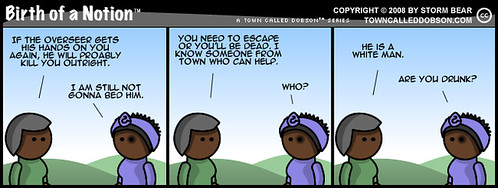Crossposted from Left Toon Lane, Bilerico Project & My Left Wing

click to enlarge
The Underground Railroad was an informal network of secret routes and safe houses used by 19th century Black slaves in the United States to escape to free states (or as far north as Canada) with the aid of abolitionists who were sympathetic to their cause. The term is also applied to the abolitionists who aided the fugitives. Other routes led to Mexico or overseas. The Underground Railroad was at its height between 1810 and 1850. One report estimates that up to 100,000 people escaped enslavement via the Underground Railroad, but census figures only account for 6,000.
Even at the height of the Underground Railroad, fewer than two thousand slaves from all slaveholding states were able to escape each year, a quantity much smaller than the natural annual increase of the enslaved population. Though the economic impact was small, the psychological impact upon slaveholders of a well-organized network to assist escaped slaves was immense. Under the original Fugitive Slave Law of 1793, the responsibility for catching runaway slaves fell to officials of the states from whence the slaves came, and the Underground Railroad thrived.
With heavy political lobbying, the Compromise of 1850, passed by Congress after the Mexican-American War, stipulated a more stringent Fugitive Slave Law. Ostensibly, the compromise redressed all regional complaints. However, it coerced officials of free states to assist slave catchers if there were runaway slaves in the area, and granted slave catchers national immunity when in free states to do their job. Additionally, freed blacks of the North could easily be forced into slavery, as all suspected slaves were not eligible for a trial and it was difficult to prove a free status. Thus, many Northerners who would have otherwise been able and content to ignore far-away regional slavery chafed under nationally-sanctioned slavery, leading to one of the primary grievances of the Union cause by the Civil War’s outbreak.
The escape network of The Underground Railroad was not literally subterranean, but rather “underground” in the sense of underground resistance. The network was known as a “railroad” by way of the use of rail terminology in the code. The Underground Railroad consisted of meeting points, secret routes, transportation, and safe houses, and assistance provided by abolitionist sympathizers. Individuals were often organized in small, independent groups, which helped to maintain secrecy since some knew of connecting “stations” along the route but few details of their immediate area. Escaped slaves would move along the route from one way station to the next, steadily making their way north. “Conductors” on the railroad came from various backgrounds and included free-born blacks, white abolitionists, former slaves (either escaped or manumitted), and Native Americans. Churches also often played a role, especially the Religious Society of Friends (Quakers), Congregationalists, Wesleyans, and Reformed Presbyterians as well as certain sects of mainstream denominations such as branches of the Methodist church and American Baptists.
For more details check out National Geographic’s site for the Underground Railroad
Disclaimer:
When I went to school, we were never taught Black History. We never learned about the Black leaders, the long, agonizing history that brought most Blacks to America. Those atrocities were glossed over in favor of mindlessly boring topics like the X Y Z Affair.
This series of cartoons will review Black history as told from a Black mother to an interracial child. This series will be ugly, course, horrific and truthful. I will mostly abandon the commentary for an article on Black history.
This series is not about Obama or Hillary. I want to you to try to imagine how Black families tell their children of the atrocities their ancestors, all of them, suffered because of the color of their skin. Try to imagine how Black families counsel their children when someone calls them “nigger” for the first time. Can you imagine the bone crushing emotion that must well up? Can you imagine the agony, frustration and anger?
Can you imagine being the Black preacher who tries to paint a picture of a just God every Sunday? Especially in a country that claims where the notion of racism is a thing of the past, the job is difficult.
These strips may at times be entertaining and sometimes they may not – mostly not.
I don’t want you to laugh so hard you cry, I want you to cry so hard you do something about it.
BIRTH OF A NOTION WALLPAPER is now available for your computer. Click here.


